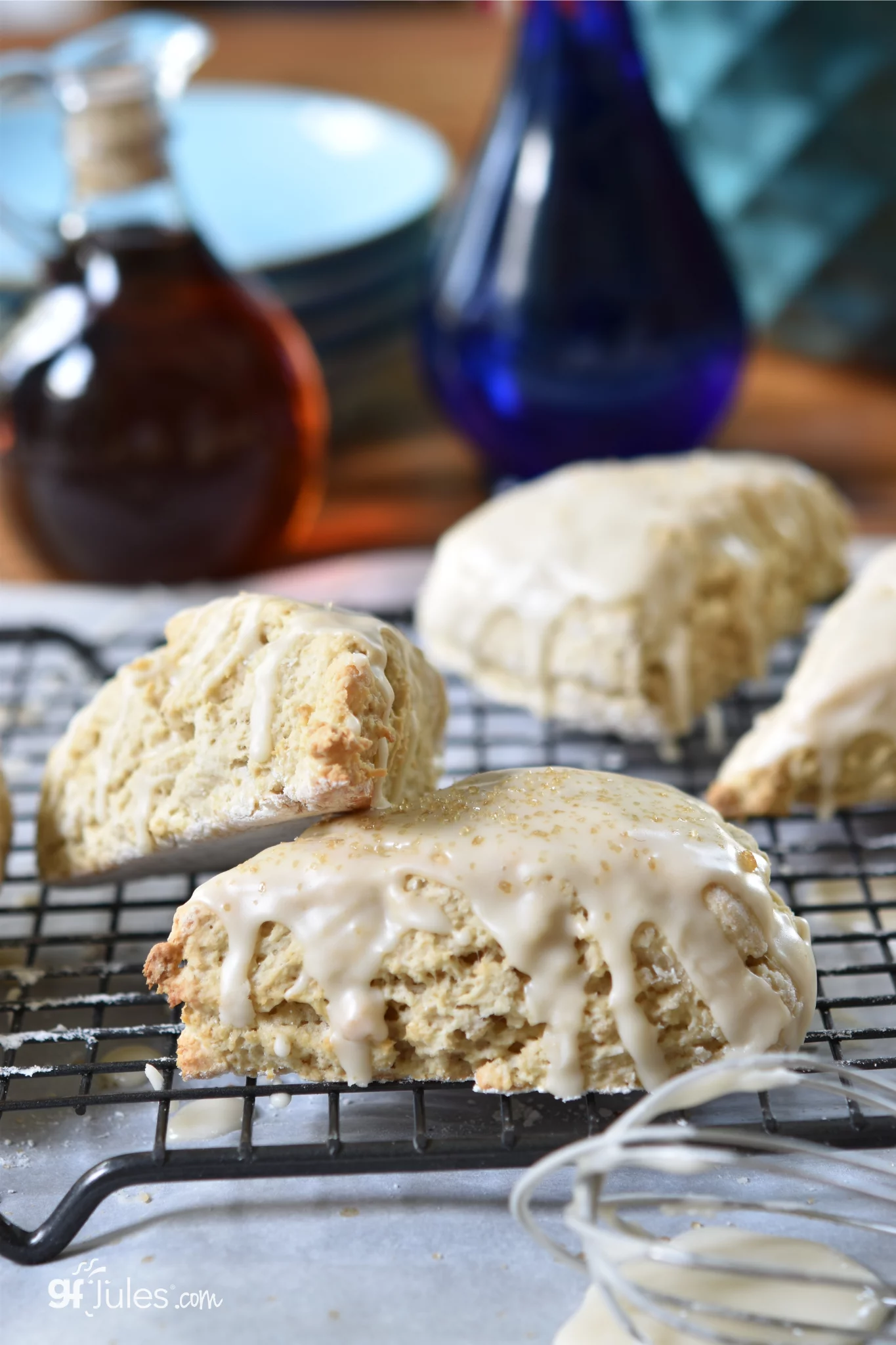
Gluten Free Oat Scones
Pure maple syrup is the star of these delicious gluten free oat scones. Maple flavor permeates both the light scones and the glaze, making these a fall favorite!
Print
Pin
Servings: 12 -12, depending on size
Calories: 163kcal
Ingredients
- 1 1/4 cups Certified Gluten-Free and Purity Protocol Oats
- 2 cups gfJules™ All-Purpose Gluten Free Flour
- 1/4 cup granulated cane sugar
- 1/2 teaspoon baking soda
- 2 teaspoons baking powder
- 1/4 cup butter or non-dairy alternative (like Earth Balance® Buttery Sticks)
- 2 large eggs OR egg substitute like 2 Tbs. flaxseed meal steeped in 6 Tablespoons hot water until viscous
- 1 cup vanilla yogurt — dairy or non-dairy (like So Delicious® Yogurt)
- 2 Tablespoons pure maple syrup or dark agave nectar
Glaze – optional
- 1 1/2 cups confectioner’s sugar
- 2 Tablespoons + vanilla dairy or non-dairy milk (like So Delicious® Vanilla Coconut Milk)
- 2 Tablespoons pure maple syrup or dark agave nectar
Instructions
- Preheat the oven to 400° F (static) or 375° F (convection, preferred).
- Pour the oats into a blender or food processor and blend into a fine flour.
- In a large bowl whisk together the dry oat flour, all purpose gluten-free flour, sugar, baking soda and baking powder. Cut in the shortening using a pastry cutter, two knives or an electric mixer.
- In a small bowl, stir the eggs together with a fork to mix. If making egg substitute using flax seed meal, steep in very warm water until the flax has absorbed nearly all of the water. Pour eggs or flax seed meal mixture into the mixed dry ingredients, then add the yogurt and maple syrup. Stir well to combine.
- Turn the dough onto a clean counter or pastry mat dusted with gluten free flour or cornstarch. Coat your hands with the flour as well, then scoop the dough in a ball onto the mat.
- Pat the dough out into a flat rectangle, 1 1/2 - 2 inches thick. Using a butter knife or bench scraper, cut the dough into sections, then cut each section into smaller triangles. You should wind up with 8-12 triangle-shaped scones. Make sure there is not too much extra flour on the tops of the scones before baking – brush off lightly with a pastry brush, if necessary. Brush the tops with egg wash, aquafaba, milk or oil if you would prefer them to brown a bit.
- Place each scone onto a parchment-lined cookie sheet and bake in the preheated oven for approximately 10 minutes, or until they spring back when lightly touched and a toothpick inserted into the center comes out clean or with dry crumbs. Do not over cook! Remove the entire baking sheet to a cooling rack.
- After cooling for at least 5 minutes, stir together the glaze ingredients, adding the milk only one tablespoon at a time until it reaches a pourable, but not thin, glaze consistency. Slowly pour over the tops of each scone. Some of the glaze will pool around the scones onto the parchment paper, so leave the scones on the baking sheet for this glaze step unless you are serving immediately and want the glaze to pool on the serving plates.
Video
Nutrition Facts
Gluten Free Oat Scones
Serving Size
1
Amount per Serving
Calories
163
% Daily Value*
Fat
5
g
8
%
Saturated Fat
3
g
19
%
Polyunsaturated Fat
2
g
Cholesterol
42
mg
14
%
Sodium
210
mg
9
%
Carbohydrates
27
g
9
%
Sugar
25
g
28
%
Protein
3
g
6
%
* Percent Daily Values are based on a 2000 calorie diet.
** Please keep in mind that nutrition information provided is per serving, which may vary. While we have taken care to provide you with the most accurate nutritional values possible, please note that this information may differ significantly depending on the exact ingredients and brands that you choose to use to make this recipe. Additionally, where options are given for ingredients, the resulting calculation may include all ingredient options instead of only one per line, skewing the totals significantly.